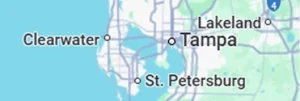Pinellas County is home to many varieties of beautiful pine trees. The most common are the Slash Pine and the Sand Pine. While these trees add value and beauty to the Pinellas landscape, they are very susceptible to beetle infestation. Namely, the Ips Engraver Beetle. Trees attacked by Ips bark beetles, whether in the forest or around the home, are usually noticed when needles turn yellow or red. Upon closer examination, infested trees will have dry, reddish-brown boring dust in the bark crevices. Some trees may have dime-size or smaller, white to reddish-brown projections, called pitch tubes in the bark crevices
Ips beetles usually attack weakened, dying, or recently felled trees and fresh logging debris. Large numbers Ips may build up when natural events such as lightning storms, ice storms, tornadoes, wildfires, and droughts create large amounts of pine suitable for the breeding of these beetles. Ips populations may also build up following forestry activities, such as prescribed burns that get too hot and kill or weaken pines and clear-cutting or thinning operations that compact soils, wound trees, and leave large amounts of branches, cull logs, and stumps for breeding sites.Adult Ips beetles carry numerous spores of a bluestain fungus, Ceratocystis ips (Rumbold) C. Moreau, in their gut. When the adults attack trees or logging slash, the bluestain spores are excreted with beetle feces into egg galleries, where the spores germinate. Bluestain fungus colonies grow into the outer sapwood of infested pines, stopping the upward flow of water to the tree crown. Lack of water causes needles to wilt and die, gradually changing their color, from dull green to yellow green to red brown. These color changes may occur in 2 to 4 weeks during the summer, but take several months in the winter.
B&T’s Tree Service in Clearwater recommends complete tree removal when trees are infested with Ips Engraver Beetles.



